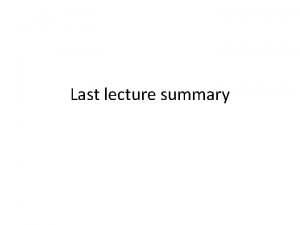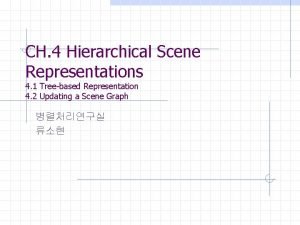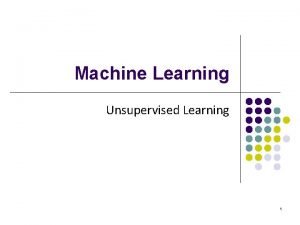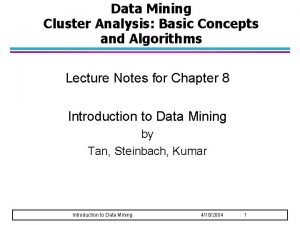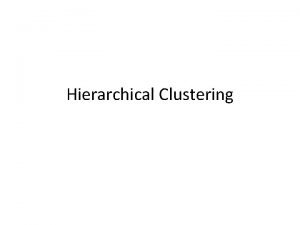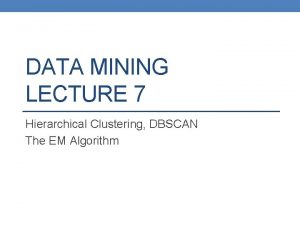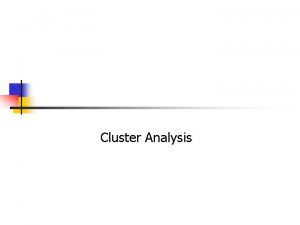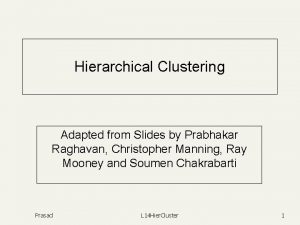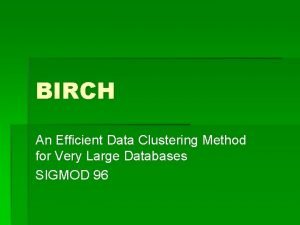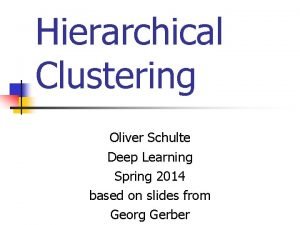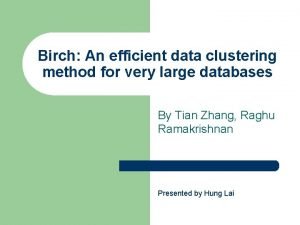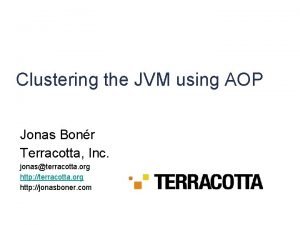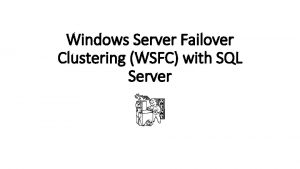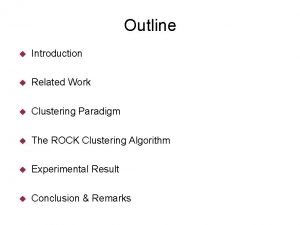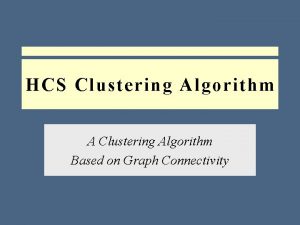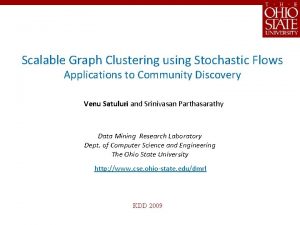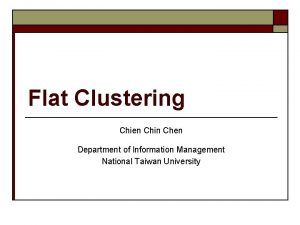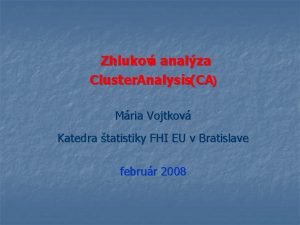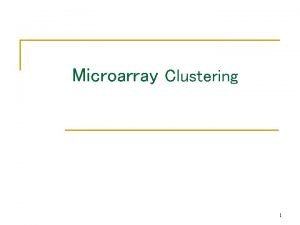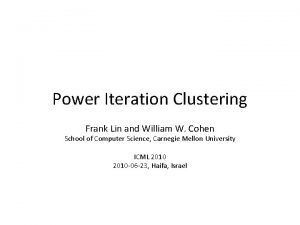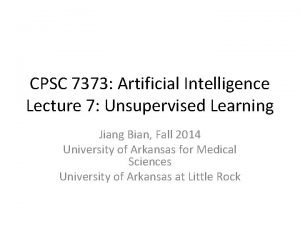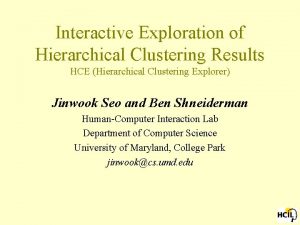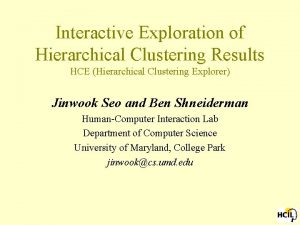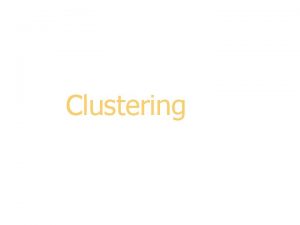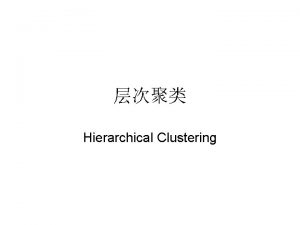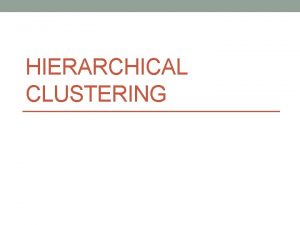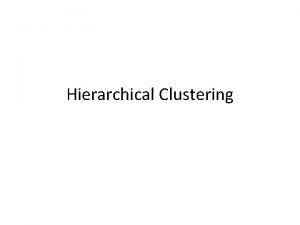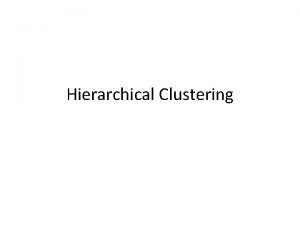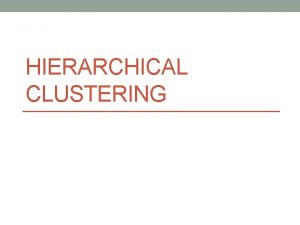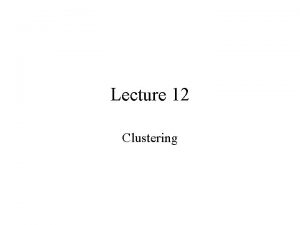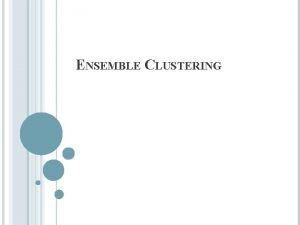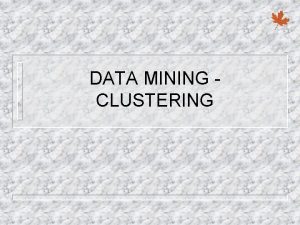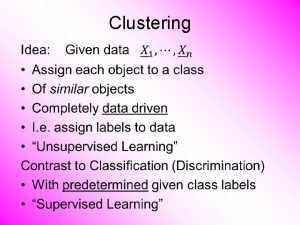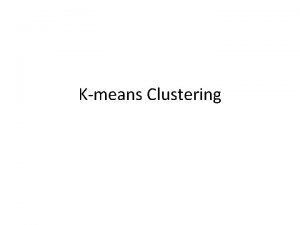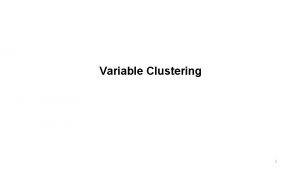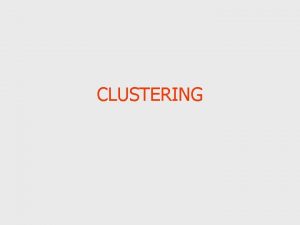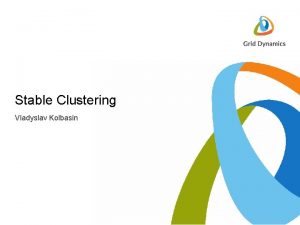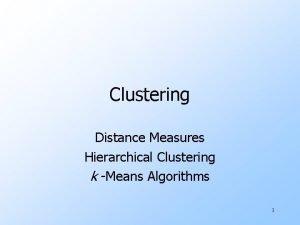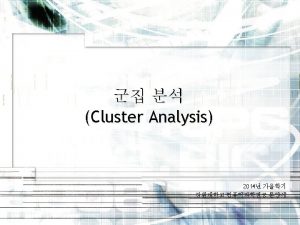Interactive Exploration of Hierarchical Clustering Results HCE Hierarchical

























- Slides: 25

Interactive Exploration of Hierarchical Clustering Results HCE (Hierarchical Clustering Explorer) Jinwook Seo and Ben Shneiderman Human-Computer Interaction Lab Department of Computer Science University of Maryland, College Park jinwook@cs. umd. edu

Cluster Analysis of Microarray Experiment Data • About 100 ~ 20, 000 gene samples • Under 2 ~ 80 experimental conditions • Identify similar gene samples – startup point for studying unknown genes • Identify similar experimental conditions – develop a better treatment for a special group • Clustering algorithms – Hierarchical, K-means, etc.

Dendrogram -3. 64 4. 87

Dendrogram -3. 64 4. 87

Dendrogram -3. 64 4. 87

Interactive Exploration Techniques • Dynamic Query Controls – Number of clusters, Level of detail • Coordinated Display – Bi-directional interaction with 2 D scattergrams • Overview of the entire dataset – Coupled with detail view • Visual Comparison of Different Results – Different results by different methods

Demonstration • 99 Yeast genes • 7 variables (time points) • Download HCE at – www. cs. umd. edu/hcil/multi-cluster • More demonstration – A. V. Williams Bldg, 3174 – 3: 30 -5: 00 pm, May 31.

Dynamic Query Controls Filter out less similar genes § By pulling down the minimum similarity bar § Show only the clusters that satisfy the minimum similarity threshold § Help users determine the proper number of clusters § Easy to find the most similar genes

Dynamic Query Controls Adjust level of detail § By dragging up the detail cutoff bar § Show the representative pattern of each cluster § Hide detail below the bar § Easy to view global structure

Coordinated Displays • Two experimental conditions for the x and y axes • Two-dimensional scattergrams – limited to two variables at a time – readily understood by most users – users can concentrate on the data without distraction • Bi-directional interactions between displays

Overview in a limited screen space • What if there are more than 1, 600 items to display? • Compressed Overview : averaging adjacent leaves • Easy to locate interesting spots Melanoma Microarray Experiment (3614 x 38)

Overview in a limited screen space • What if there are more than 1, 600 items to display? • Alternative Overview : changing bar width (2~10) • Show more detail, but need scrolling

Cluster Comparison • • There is no perfect clustering algorithm! Different Distance Measures Different Linkage Methods Two dendrograms at the same time – Show the mapping of each gene between the two dendrograms – Busy screen with crossing lines – Easy to see anomalies

Cluster Comparison

Conclusion • Integrate four features to interactively explore clustering results to gain a stronger understanding of the significance of the clusters – Overview, Dynamic Query, Coordination, Cluster Comparison • Powerful algorithms + Interactive tools • Bioinformatics Visualization www. cs. umd. edu/hcil/multi-cluster July 2002 IEEE Computer Special Issue on Bio. Informatics

Hierarchical Clustering Initial Data Items Distance Matrix Dist A B C D D A B C D 20 7 2 10 25 3

Hierarchical Clustering Initial Data Items Distance Matrix Dist A B C D D A B C D 20 7 2 10 25 3

Hierarchical Clustering Single Linkage Current Clusters Distance Matrix Dist A B C 2 A D B C D A B C D 20 7 2 10 25 3

Hierarchical Clustering Single Linkage Current Clusters Distance Matrix Dist AD B C AD 20 3 B C A D B C 10

Hierarchical Clustering Single Linkage Current Clusters Distance Matrix Dist AD B C AD 20 3 B C A D B C 10

Hierarchical Clustering Single Linkage Current Clusters Distance Matrix Dist AD B C AD 20 3 B C 3 A D C B 10

Hierarchical Clustering Single Linkage Current Clusters Distance Matrix Dist ADC B ADC 10 B A D C B

Hierarchical Clustering Single Linkage Current Clusters Distance Matrix Dist ADC B ADC 10 B A D C B

Hierarchical Clustering Single Linkage Current Clusters Distance Matrix 10 Dist ADC B ADC 10 B A D C B

Hierarchical Clustering Single Linkage Final Result Distance Matrix Dist ADC B A D C B
 Flat clustering vs hierarchical clustering
Flat clustering vs hierarchical clustering Flat clustering
Flat clustering L
L Unsupervised hierarchical clustering
Unsupervised hierarchical clustering Bayesian hierarchical clustering
Bayesian hierarchical clustering Hierarchical clustering
Hierarchical clustering Hierarchical clustering applications
Hierarchical clustering applications Cluster data mining
Cluster data mining A set of nested clusters organized as a hierarchical tree
A set of nested clusters organized as a hierarchical tree Dbscan hierarchical clustering
Dbscan hierarchical clustering Hierarchical clustering spss
Hierarchical clustering spss Hierarchical clustering
Hierarchical clustering Cf tree in data mining
Cf tree in data mining Hierarchical clustering demo
Hierarchical clustering demo Birch clustering
Birch clustering Shadow and bonr
Shadow and bonr Wsfc sql server
Wsfc sql server Rock clustering algorithm
Rock clustering algorithm Hcs clustering algorithm
Hcs clustering algorithm Graph clustering by flow simulation
Graph clustering by flow simulation Flat clustering
Flat clustering Clustering metoda
Clustering metoda Clustering outline
Clustering outline Power iteration clustering
Power iteration clustering Classification and clustering in data mining
Classification and clustering in data mining Spectral clustering
Spectral clustering



